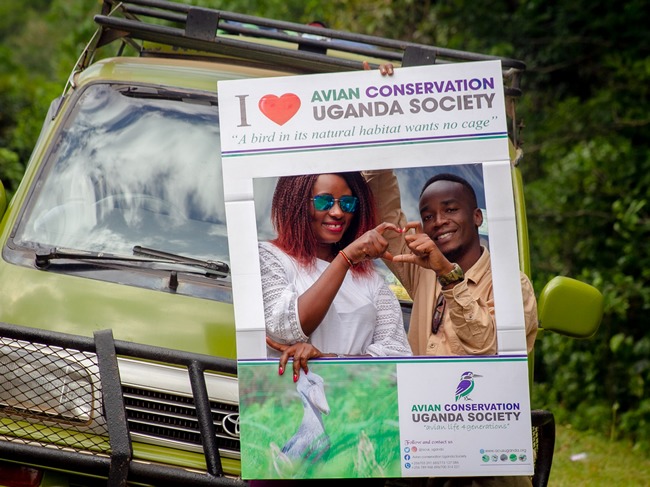Bird Conservation Is A Key Element For Uganda’s Transformation Into A Modern
Uganda’s rich biodiversity is not complete without the vibrant presence of its avian species. From the majestic crested crane, Uganda’s national bird, to the melodious songs of colorful Sun birds, birds hold a special place in the hearts of the Ugandan people. Bird conservation in Uganda goes beyond protecting our feathered friends; it influences our culture, nurtures mental well-being, stimulates economic growth through avian tourism and food resources, and preserves our precious ecosystems. In this article, we explore how bird conservation contributes to societal transformation, emphasizing Uganda’s unique social, economic, and environmental. This is in line with SDGs 12, 13 and 15
CLIMATIC CHANGE ADAPTATION.
Climate change is one of the most pressing global challenges, and its impacts are felt across ecosystems and species, including birds. Birds are highly sensitive to changes in temperature, rainfall patterns, and habitat availability, making them valuable indicators of environmental health and climate change impacts. By monitoring bird populations, researchers and conservationists can gain crucial insights into the changing ecological conditions and devise effective adaptation strategies for both avian species and broader ecosystems.
In Uganda, a country known for its rich biodiversity and unique avian diversity, climate change poses significant threats to birds and their habitats. Here are examples on how bird monitoring and conservation efforts can aid in climate change adaptation.
The African Pitta is a migratory bird species that travels long distances to breed in Uganda during the wet season. Changes in its migratory patterns, such as arriving earlier or later than usual, can indicate shifts in rainfall patterns and climate conditions.
The other the Crested Crane is an iconic bird species in Uganda and is highly susceptible to changes in wetland habitats, which are influenced by climate factors like rainfall and water availability. Monitoring the population trends of these cranes can provide insights into the health of wetland ecosystems and their adaptation to climate change.
Forest-dependent bird species, like the Green-breasted Pitta, are particularly vulnerable to habitat loss and fragmentation driven by climate change. Conservation efforts aimed at protecting and connecting forest habitats can enhance.
CULTURAL SIGNIFICANCE OF BIRDS IN UGANDA
Birds are deeply embedded in Ugandan culture, symbolizing unity, freedom, and prosperity. The crested crane, often depicted in traditional dance and art, represents national pride and loyalty. Various tribes such as the Baganda hold unique beliefs about specific bird species such as owls (ekiwuggulu), associating them with ancestral spirits and good fortune. The enchanting calls and vibrant colors of birds have inspired Ugandan folklore, songs, and tales such as that of “wakonfu ne wango”, reflecting our intimate connection with nature.
Preserving bird habitats and safeguarding threatened species, such as the African Gray parrot and Shoebill Stork, is not only an ecological responsibility but also vital for preserving our cultural heritage.
BIRDWATCHING AS A SOURCE OF MENTAL HEALTH AND WELL-BEING
Uganda’s diverse bird life provides an enriching experience for birdwatching enthusiasts and novices alike. The country’s lush forests, wetlands, and savanna offer ideal settings for birdwatchers to immerse themselves in nature and find tranquility amid the hustle and bustle of daily urban life.
Birdwatching has emerged as a recreation activity impacting mental health and well-being. As Ugandans venture into the wilderness to spot elusive species like the African Pitta or the Great Blue Turaco, they find solace in the symphony of bird calls and the vibrant display of colors, thus reducing stress and promoting overall mental wellness.
SUSTAINABLE TOURISM AND ECONOMIC DEVELOPMENT.
Uganda’s avian treasures attract birdwatchers and nature enthusiasts from around the world, driving avian tourism and contributing significantly to the country’s economy. Tours, guided by expert local ornithologists, generate employment opportunities and create a market for eco-friendly accommodations and sustainable travel.
Protected areas like Queen Elizabeth National Park and Mabamba Swamp have become prime avian tourism destinations, promoting the conservation of bird habitats while providing a source of income for local communities. The economic benefits of avian tourism support livelihoods and encourage environmental stewardship among locals.
FOOD SECURITY
Birds play a pivotal role in Ugandan agriculture by acting as essential pollinators, ensuring the reproduction of crops like coffee and fruits. Their foraging activities help control insect pests, minimizing the need for chemical pesticides and promoting sustainable agricultural practices.
Moreover, bird species like the guinea fowl and pigeon provide a valuable source of protein, contributing to food security for communities across the country. Integrating bird conservation efforts into agricultural practices supports crop yield and ensures a balanced ecosystem.
BIODIVERSITY AND ECOSYESTEM SERVICES
The preservation of bird habitats is critical in the effort to maintain Uganda’s rich biodiversity and ecological balance. By safeguarding bird species and their habitants, ACUS contributes to the overall biodiversity preservation ensuring stability of natural ecosystems in Uganda.
For instance, the African Harrier Hawk is a Raptor found in various habitants across Tropical Africa including Uganda. It feeds on insects, small rodents and frogs reducing keeping their numbers in check for ecological balance. Rodents in large numbers would be a pest threat to agricultural produce in the garden and in the store.
Additionally, as the Great Blue Turaco that primarily feeds on ripe fruits and berries flies from tree to tree, it deposits seeds through droppings contributing to dispersal of seeds in the forest landscape.It is important and vital in forest regeneration.
IN CONCLUSION
Bird conservation in Uganda is an expression of our reverence for nature and recognition of the vital role that birds play in shaping our society. Beyond ecological preservation, bird conservation influences our culture, fosters mental well-being, stimulates economic growth through avian tourism, enhances food security, and safeguards our precious ecosystems.
By Regan Okia


